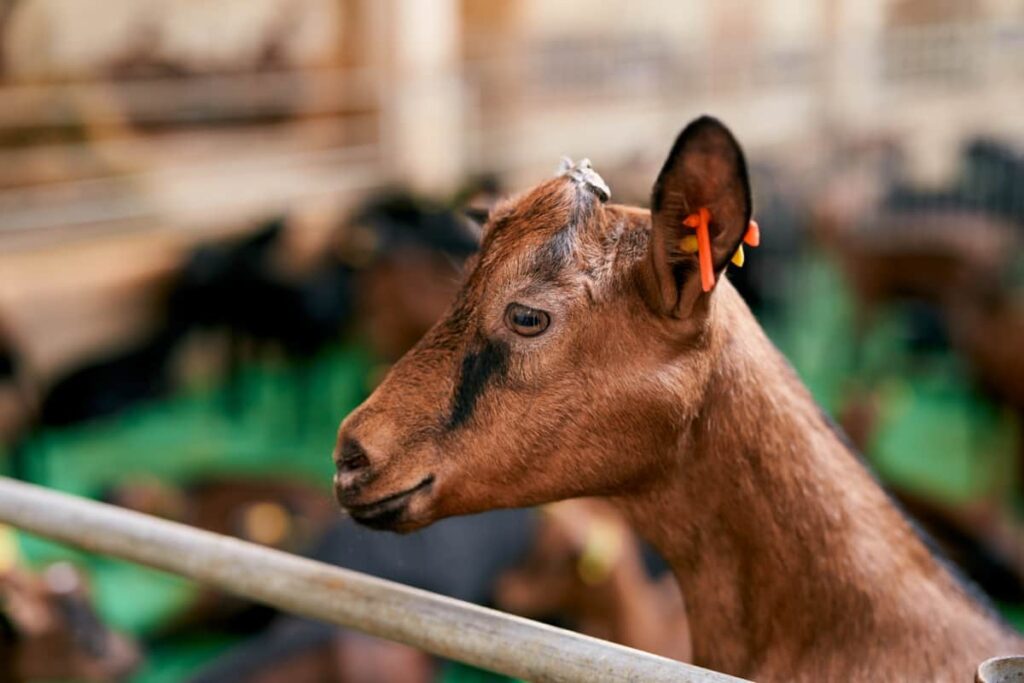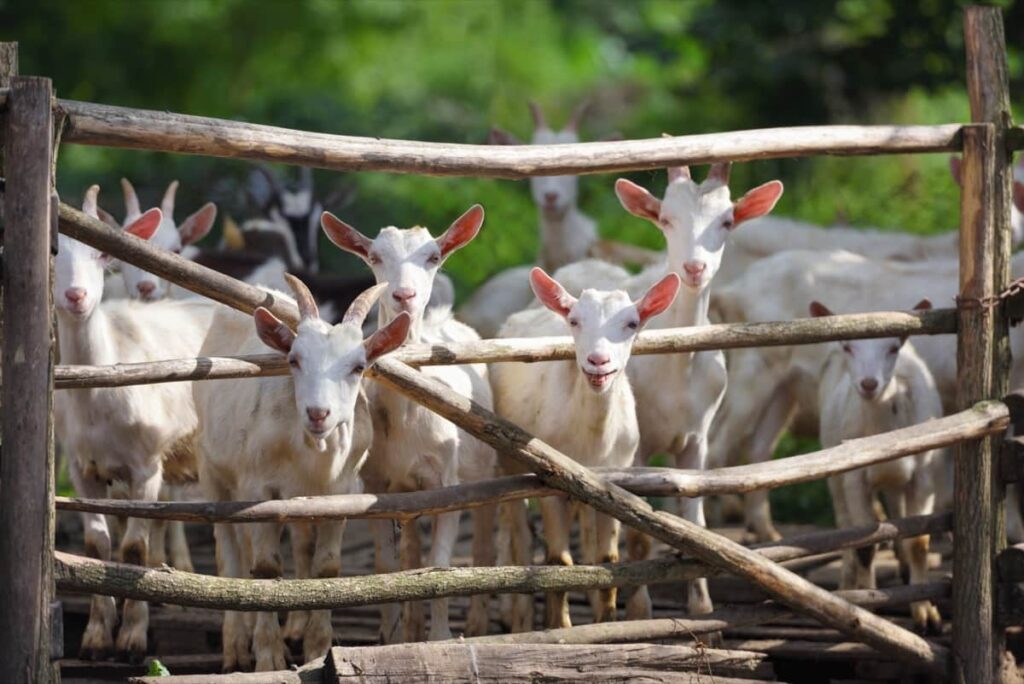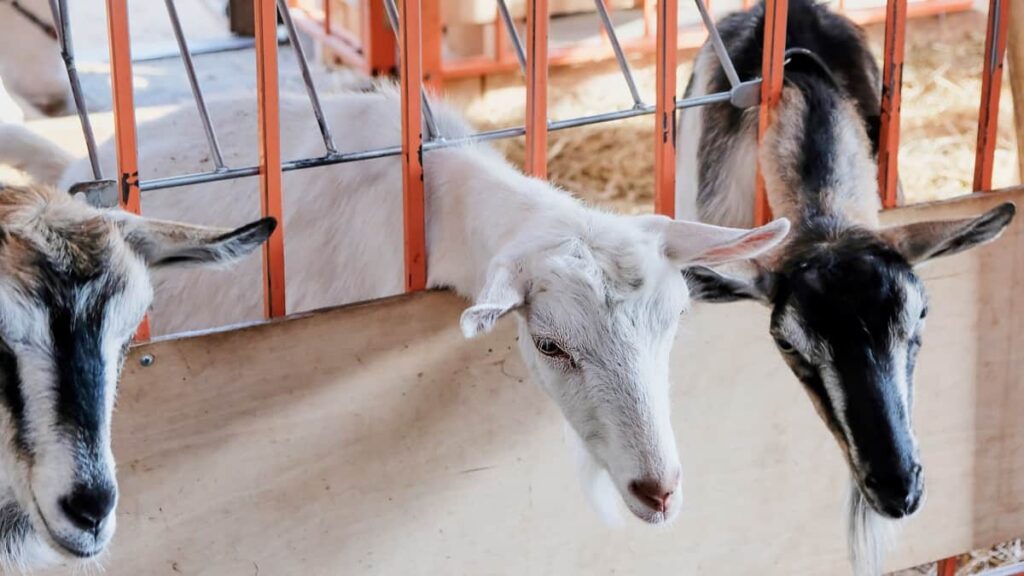Goat raising is an agricultural practice of rearing goats for their milk, meat, and fiber. Goats are social animals which makes them easy to handle and care for. They can adapt to different climates and terrains, making them perfect pets or livestock on farms.

Goat Raising Basics
The Different Types of Goats
- Goats come in different shapes, sizes, and colors. Each breed has unique characteristics that make them suitable for specific purposes. The most common goats are meat, dairy, and fiber goats.
- Meat goats are bred for their meat rather than milk production. Some popular breeds include the Boer goat from South Africa and Kiko goat from New Zealand – both excellent choices for commercial farming.
- Dairy goats produce high-quality milk that is rich in butterfat content compared to cow’s milk. Common dairy goat breeds include Nubian, Alpine, and LaMancha- they are known to produce more significant amounts of milk while still being easy to manage.
- Fiber Goats, or Angora Goats, are mainly prized for their wool used in clothing-making processes like shawls or yarn mills. Mohair comes primarily from the Angora Goat breed that originated in Turkey but is now available worldwide.
- Other popular fiber breeds include Pygora Goats (crossbreed between Angoras & Pygmy) and Cashmere Goats.
Feed and Nutrition Requirements for Raising Goats
- Feeding and nutrition are crucial aspects of goat raising. As herbivores, goats feed on grasses, leaves, and other plant materials. However, their dietary requirements vary depending on age, breed, weight, and gender.
- Newborn kids require colostrum in the first few hours after birth to boost their immune system. Afterward, they can be fed with milk replacers or fresh milk from the mother doe until they reach three months old, when they can start eating solid feeds such as hay and grain.
- For adult goats, a balanced diet should consist of good quality hay or pasture supplemented with grains like corn or oats for energy. They also need mineral supplements to meet their daily nutritional requirements.
- Providing a well-balanced diet rich in essential nutrients is vital for maintaining healthy goats capable of producing high-quality products such as meat or milk.
Housing and Shelter Needs for Raising Goats
- The most important factor is providing them with a safe and secure environment. Goats need protection from predators, extreme weather conditions, and other hazards.
- The flooring inside the enclosure should also be easy to clean, non-slippery, and free from sharp edges that could damage their hooves.
- Ensure adequate feeding troughs and waterers within the shelter so your goats can access food and water whenever needed.
- Providing proper housing and shelter for your goats is essential for their health and well-being.
Breeding Management Practices in Goats
- Breeding goats can be a fun and rewarding experience. Before breeding your goats, it’s important to ensure they are healthy and in good condition. It would help if you also considered the breed of goat, you have and whether or not it is suitable for breeding.
- When choosing a mate for your goat, look for one that has desirable traits such as good milk production or strong genetics. It’s also important to ensure the buck is free from genetic defects or diseases.
- Once you’ve selected a mate for your goat, it’s time to introduce them slowly so they can get used to each other before mating occurs. This will help reduce stress on both animals and improve the chances of successful breeding. After mating, keep an eye on your doe and watch for signs of pregnancy, such as an enlarged udder or changes in behavior.
- A clean and dry pen should be set up beforehand with fresh bedding material such as straw or wood shavings. The pen should also be free from sharp objects that may harm the newborns.
In case you missed it: Goat Breeding and Genetics for Improved Productivity and Disease Resistance

Health Care and Preventative Measures in Goat Farming
- Proper health care and preventative measures are essential for the well-being of your goats.
- Schedule regular check-ups with a veterinarian who specializes in goat care. They can provide vaccinations, deworming treatments, and hoof-trimming services.
- Next, monitor your goats’ behavior and physical appearance daily.
- Practice good biosecurity measures by keeping new animals isolated until they’ve been checked for potential diseases or illnesses that could spread throughout the herd.
- Another crucial aspect of goat health care is proper nutrition. Goats should always have access to clean water and a balanced diet of hay, grains, and minerals. Overfeeding or underfeeding can lead to various health problems, such as obesity or malnutrition.
- Regular check-ups with a veterinarian are also recommended to keep track of any potential illnesses or infections. Vaccinations against common diseases like tetanus, pneumonia, and clostridium perfringens type C & D are necessary for healthy goats.
- It’s also essential to monitor your goat’s behavior for signs of sickness like loss of appetite or lethargy. If you observe anything unusual, don’t hesitate to contact your vet immediately.
Common Goat Diseases and How to Treat Them?
- Goats are susceptible to various diseases that can impact their health and well-being. Some common goat illnesses and diseases include respiratory infections, parasites, mastitis, and foot rot.
- Respiratory infections in goats often present as coughing, nasal discharge, or labored breathing. To treat these symptoms, isolate the infected goat from the rest of your herd to prevent spreading. You may also need to administer antibiotics prescribed by a veterinarian.
- Parasites such as worms or lice can cause weight loss, diarrhea, and anemia in your goats. Regular deworming is essential for preventing infestations of internal parasites, while external parasites like lice require topical treatments.
- Mastitis is a udder infection which causes swelling and discomfort for the goat. It’s important to catch and treat mastitis early on with antibiotics before it becomes serious enough to require surgical intervention.
- Foot rot occurs when bacteria enter a cut or scrape on a goat’s hoof, causing swelling, lameness, and pain. Proper sanitation practices in housing areas can help prevent this condition, but treatment may involve trimming away damaged tissue followed by medication application.
How to Care for a Goat?
- Feed and Water: Goats need fresh water daily and should have access to hay throughout the day. You can supplement their diet with grains, fruits, vegetables, or commercial goat feed.
- Shelter: A shelter that protects from extreme weather conditions such as rain and heat is necessary for goats. They should also have enough space to move around freely.
- Grooming: Regular grooming helps keep goats clean and healthy. This includes trimming hooves every six weeks, brushing their coat regularly, and checking them for signs of illness.
- Healthcare: Vaccinations are essential in preventing diseases common among goats. Deworming is also important at least twice a year to prevent parasitic infections.
- Exercise: Goats enjoy exercise by jumping on rocks or logs or playing with other animals. Encourage regular exercise routines to promote good health.
In case you missed it: Innovative Housing and Shelter Designs for Profitable Goat Farming

Conclusion
Goats are versatile and multipurpose animals that can provide milk, meat, and fiber. Proper nutrition is critical for your goats’ healthy growth and development. They require a balanced diet of hay or pasture grasses and grains like corn or oats. Goats are relatively easy to keep and require less space than other livestock.
- Goat Milking Practices and Equipment: A Beginner’s Guide
- Goat Farming for Fiber: Producing Mohair and Cashmere
- Maximizing Goat Milk Production: Tips for Dairy Goat Farmers
- Goat Farming as a Family Business: Strategies for Success
- Profitable Kenya Goat Breeds for Commercial Dairy and Meat Business
- Unlock the Secrets of Oberhasli Goat: Discover Raising and Management Practices
- Ultimate Guide to Myotonic Goats: Explore Profile to Raising
- Unlock the Secrets of Rove Goat: Discover Management Practices
- Ultimate Guide to Malwa Goat: Explore from Origin to Management Practices